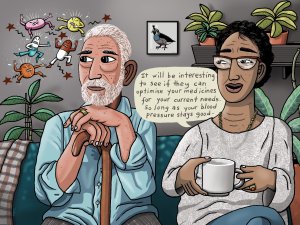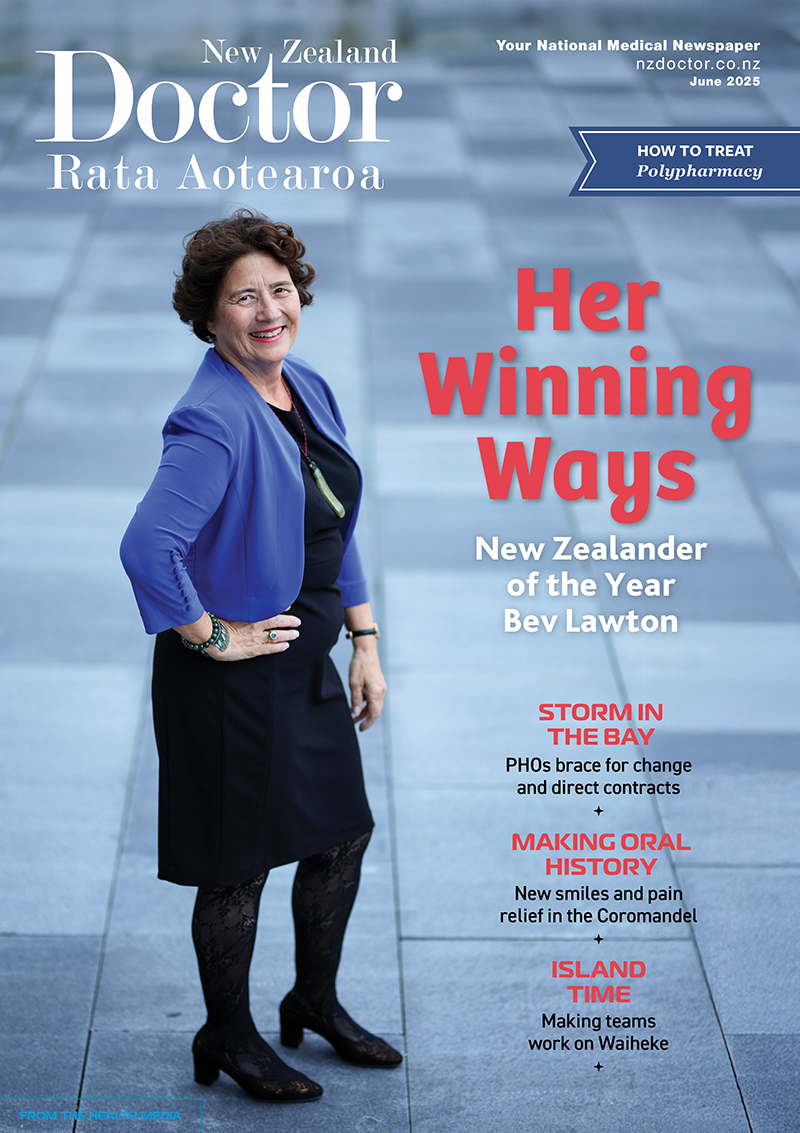For older people and frail people, the long-term benefit of medicines reduces and the potential for harm from adverse effects increases. When the benefit–risk balance changes in this way, medicine review and optimisation are important to simplify the therapeutic regimen, reduce inappropriate medicines and minimise risks. In this article, pharmacist prescriber Linda Bryant uses two case studies to illustrate important considerations during medicine reviews
Data showing alarmingly low immunisation rates, delays, costs still undermining Māori Health
Data showing alarmingly low immunisation rates, delays, costs still undermining Māori Health

Te Tiratū Iwi Māori Partnership Board April Whānau Voice Report mirrored by Te Whatu Ora data has evidenced immunisation rates 33% lower than the national average, widespread inequities, long wait times, and unaffordable care still plaguing whānau Māori in its Tainui waka rohe.
The Board, which holds legislative responsibilities under the Pae Ora (Healthy Futures) Act 2022 to represent Māori voices in health and monitor health system delivery of Te Whatu Ora, gathered lived experiences from 53 whānau across its rohe.
Behind every statistic is a whānau member struggling in silence.
The April Whānau Voice report revealed:
- 23% of whānau identified access to care—like GP appointments or surgeries—as their biggest barrier.
- 27% said cost was the major obstacle, forcing choices between essentials like kai and medication.
- 14% highlighted the need for more culturally safe, Māori-led care.
“Whānau are still waiting—too long—for care that should be timely and accessible,” said Hagen Tautari, co-chair of Te Tiratū Iwi Māori Partnership Board.
“One kuia told us her husband had life-saving heart surgery, but no specialist follow-up for almost a year. Another Māmā has waited two years for her child’s ear operation. These are not exceptions—they are systemic failures.”
Whānau are being left to manage complex conditions like diabetes, cancer, and heart disease with minimal support. Many avoid primary care due to cost and instead turn to overburdened emergency departments—even for non-urgent issues.
“We go to hospital because there’s nowhere else,” said another whānau.
In rural areas, lack of transport compounds the problem. Some whānau reported sitting in shuttle vans for hours to access basic services. Others gave up entirely.
Cultural safety also emerged as a major issue for whānau, ironically at a time when the government is looking to proactively remove cultural requirements from workforce regulation.
While Māori health workers were praised for their manaakitanga, whānau shared painful stories of clinical encounters with the non-indigenous workforce that lacked empathy, understanding, or cultural connection.
“We need more Māori nurses and doctors,” said one whānau. “They didn’t just treat us—they respected us.” But the report goes beyond what’s broken. Whānau were clear about what needs to change.
Priorities included:
- More doctors, more appointments, and reduced wait times (24%)
- Lower costs for basic care (27%)
- Improved transport and localised services (14%)
- More culturally grounded, Māori-led health care (14%)
- Better coordination between health services (13%)
- Holistic, whānau-centred support for housing, income, and wellbeing (10%)
Data from Te Whatu Ora for Waikato as at 31 December 2024 reinforces these concerns:
- HPV Vaccination rates for Māori aged 14 are only 46%, far from where they need to be to prevent sexually transmitted diseases and cervical cancer.
- Tamariki immunisation rates under 24 months are alarmingly low at 62%, well below the 95% national target, increasing the risk of preventable disease outbreaks.
- Emergency Department wait times are unacceptable: 27% of Māori wait over 6 hours before being admitted, transferred, or discharged—placing undue stress on kaumatua, māmā, and tamariki.
- For elective surgery, only 65% of Māori receive timely treatment, compared to 71% of Non-Māori—leaving 35% waiting over four months.
- Cancer screening rates are critically low:
Bowel screening: only 46% for Māori aged 60–74
Breast screening: 55% for wāhine aged 45–69
Cervical screening: 58% for wāhine aged 25–69
- Cancer treatment within the 31-day target is met for only 62% of Māori, far below the 90% national goal.
“These numbers are not just data points—they’re warnings,” said Tautari. “They tell us that inequity is embedded and urgent.”
“Our care needs to reflect our world. Te ao Māori matters in healing,” one whānau member said in the Whānau Voice report.
Te Tiratū says the April report and supporting health data are a wake-up call to decision-makers across the motu. The stories and statistics are not just feedback—they are a call to action.
“We carry both a legal and moral obligation to ensure whānau voices are not only heard, but acted upon,” Tautari said.
“System change begins when we honour the truths our whānau are brave enough to share and cultivate service delivery grounded in manaakitanga, equity, and tino rangatiratanga.”




![New Zealand Doctor Rata Aotearoa editor Barbara Fountain, RNZCGP president elect and Tauranga-based specialist GP Luke Bradford, Ministry of Health clinical chief advisor rural health Helen MacGregor, and Health New Zealand Te Whatu Ora clinical director primary and community care Sarah Clarke [Image: NZD]](/sites/default/files/styles/thumbnail_cropped_100/public/2025-05/1.%20Barbara%20Fountain%2C%20Luke%20Bradford%2C%20Helen%20MacGregor%20and%20Sarah%20Clarke.jpg?itok=091NETXI)
![Ngāti Porou Oranga specialist GP Elina Pekansaari and Te Nikau Hospital specialist in general practice and rural hospital medicine David Short [Image: NZD]](/sites/default/files/styles/thumbnail_cropped_100/public/2025-05/2.%20Elina%20Pekansaari%20and%20David%20Short.jpg?itok=h5XfSBVM)
![Locum specialist GP Margriet Dijkstra and OmniHealth regional operations manager (southern) Patricia Morais-Ross [Image: NZD]](/sites/default/files/styles/thumbnail_cropped_100/public/2025-05/3.%20Margriet%20Dijkstra%20and%20Patricia%20Morais-Ross.jpg?itok=jkrtRfJC)
![Golden Bay dairy farmer and dairy industry health and safety doctoral student Deborah Rhodes, and Golden Bay Community Health specialist GP Rachael Cowie [Image: NZD]](/sites/default/files/styles/thumbnail_cropped_100/public/2025-05/4.%20Deborah%20Rhodes%20and%20Rachael%20Cowie.jpg?itok=oM0_GcJc)
![Hauora Taiwhenua clinical director rural health Jeremy Webber, Australian College of Rural and Remote Medicine president Rod Martin and Observa Care director of business operations Deborah Martin, the wife of Dr Martin [Image: NZD]](/sites/default/files/styles/thumbnail_cropped_100/public/2025-05/5.%20Jeremy%20Webber%2C%20Rod%20Martin%20and%20Deborah%20Martin%2C%20the%20wife%20of%20Dr%20Martin.jpg?itok=P_aGmX_H)
![Spark Health chief executive John Macaskill-Smith and client director Bryan Bunz [Image: NZD]](/sites/default/files/styles/thumbnail_cropped_100/public/2025-05/6.%20John%20Macaskill-Smith%20and%20Bryan%20Bunz.jpg?itok=5yJvVZ0I)
![Associate dean (rural) Kyle Eggleton, third-year medical student Roselle Winter, and second-year pharmacy student Alina Khanal, all from the University of Auckland [Image: NZD]](/sites/default/files/styles/thumbnail_cropped_100/public/2025-05/7.%20Kyle%20Eggleton%2C%20Roselle%20Winter%20and%20Alina%20Khanal.jpg?itok=RQLd3TEs)
![Health New Zealand Te Whatu Ora clinical editor and specialist in general practice and rural hospital medicine Anu Shinnamon, and Whakarongorau chief clinical officer Ruth Large [Image: NZD]](/sites/default/files/styles/thumbnail_cropped_100/public/2025-05/8.%20Anu%20Shinnamon%20and%20Ruth%20Large.jpg?itok=i5TMswY9)
![Te Kahu Hauora Practice specialist GP Jane Laver and Ngāti Kahungunu ki Tāmaki-nui-a-Rua chief operations manager Tania Chamberlain [Image: NZD]](/sites/default/files/styles/thumbnail_cropped_100/public/2025-05/9.%20Jane%20Laver%20and%20Tania%20Chamberlain.jpg?itok=jtMklaCZ)